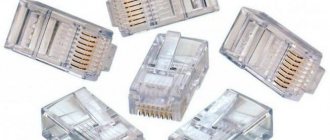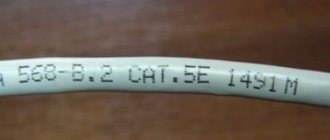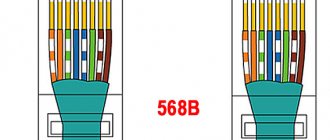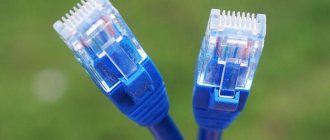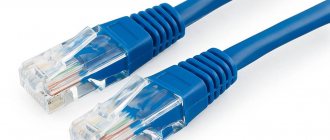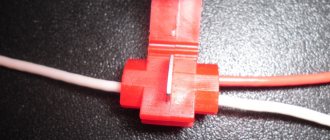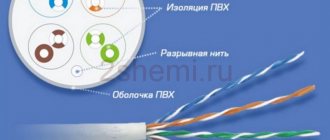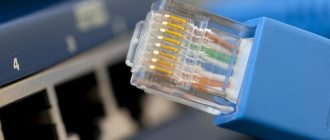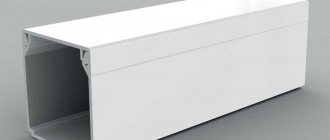Author of the article
Anton Bogdanov
Communication Network Design Engineer
Despite the fact that optical cable communication lines are gradually becoming more accessible, more devices are appearing that support working with them, and in general, working with this material is becoming easier, twisted pair cables, as before, remain the most affordable and convenient way to connect to the Internet .
Definition and device
So what is twisted pair and why is it actually twisted? The fact is that this cable consists of pairs of conductors twisted together. The choice of conductor material, number of turns, insulation and the presence of a screen determine the throughput, range and operating conditions of the cord. Internet cable is used to connect devices and transmit information using Ethernet technology.
The main difference from other cables is that one conductor wraps around the other, which is why the cable has this name. The signal is applied to both conductors of the pair at once, but along one of them it travels in antiphase. When receiving a signal through a pair of wires, the useful signal is summed (because it goes in antiphase), and the interference is subtracted (they go in the same phase). This way you can get rid of a lot of signal interference. Additionally, the cores are twisted together to reduce interference.
Connectors
Or in other words, a telecommunications connector where pairs are inserted, crimped and then connected to network equipment: routers, computers, printers, servers, switches, etc. There are several types:
NOTE! Markings will be indicated in brackets. It is usually applied to the wire itself to confirm compatibility.
RJ-9 (4P4C) – used to connect the handset to the telephone.
RJ-11 (6P2C) – for one pair of two-pin telephone connector.
RJ-12 (6P6C) – 6 contacts. It is also telephone. There are also analogues of RJ-25 (6P6C).
RJ-14 (6P4C) – 4 connectors for connecting a telephone. It differs from RJ-9 in that RJ-14 is needed to connect the phone to the network, and RJ-9 is only needed to connect the wired handset to the main device or phone.
RJ-45 (8P8C) – a connector for connecting to the network and the Internet, which has 8 contacts, just for each of our 4 pairs. For a certain type of cable and information transmission, crimping or connecting the connector to the wire is required. I will not write about this, since there is a separate article - please read it.
Application benefits
Advantages of using it over other types of cables:
- Availability;
- Easy installation due to the small thickness and flexibility of the cable;
- Convenience of working with the cable, since it does not require expensive equipment;
- Strength and durability.
Kinds
There are many types of twisted pair cables. It may differ in the number of cores, the presence or absence of shielding and the type of shell. Each of these types is suitable for a specific technology and operating conditions.
Number of cores
The wire consists of cores. The number of these cores must be a multiple of 2. At the moment, there are cables with one pair - 2 cores, with two pairs - 4 cores and four pairs - 8 cores.
Shielding
The cable can be shielded or unshielded. It is quite suitable for home use without shielding. The screen type is selected based on external conditions and possible interference with the wire.
- U/UTP – without a screen, used in homes and offices where there is no strong interference;
- FTP (F/UTP) – with a screen made of foil;
- STP (S/UTP) – shielding occurs due to copper braiding over all pairs;
- S/FTP, SF/UTP – foil on each pair and all pairs on top are shielded with copper braiding;
- U/FTP – each pair is shielded with foil;
- F/FTP – foil on each pair and a common foil layer;
- SF/FTP - this type of cable has three shields. Each pair is shielded with foil; additionally, all pairs together are shielded with foil and shielded on top with copper braiding.
The foil layer protects from the environment and oxides. Copper braiding is designed to protect the cable from electromagnetic interference.
Shell
Depending on where the cable is used, several types of sheath are used.
- PVC – plastic shell, used for indoor installation;
- PE – polyethylene layer. More durable than plastic shell, can be used outdoors;
- PP – polypropylene layer, resistant to the external environment and temperatures up to 140 degrees Celsius;
- FR – protection, capable of being in an open fire for up to 180 minutes;
- LS – when the cable burns, a minimum of smoke is released;
- ZH – non-toxic when burning;
- B – armor, used when laying cables in the ground;
- C – wire with a power element, used when suspending the cable.
Crosstalk
Both standards use copper wire, most often with 4 twisted pairs (8 wires) per wire, the difference is in the cable gauge, Category 6 uses 23 AWG, and Category 5e uses 24 AWG. American Wire Gauge (AWG) is a US standard for conductor size; the larger the gauge number, the smaller the diameter and thinner the wire. In the past, the 250 MHz performance provided by Category 6 was often achieved by using nylon splines that shielded each of the twisted pairs, reducing crosstalk, which increased speed but made the cable stiff. Currently, cables in this category are more flexible, using different separators.
Category 6 twisted pair cables have more stringent requirements for crosstalk as well as system noise. Not only does it significantly reduce near-end interference (NEXT) during transmission compared to CAT5e, but it also handles return loss (RL) and insertion loss (IL) better. The result is less noise, fewer errors and increased data transfer rates.
Categories
The most widely used category is 5e. It is this ethernet cable that connects the equipment of the provider and the apartment router. The same cable connects various devices to the router, such as a personal computer, TV, game console, etc. But there are actually many more categories. Some are no longer used due to insufficient bandwidth, while others, on the contrary, are not used in everyday life due to too high bandwidth and, therefore, high cost.
Wire is divided into categories based on the number of cores, the number of turns, and the frequency range used. These parameters will determine the data transmission speed of the twisted pair and the maximum distance it can transmit it without losing the signal.
- Cat.1 – 1 pair operating at a frequency from 0.1 to 0.4 MHz. Used for analog telephone line and Internet access via modem;
- Cat.2 – 2 pairs operating at frequencies from 1 to 4 MHz;
- Cat.3 – 4 pairs operating at 16 MHz. Used for Ethernet standard 10BASE-T (speed 10 Mbit/s) and 100BASE-T4 (100 Mbit/s). The specified speed is guaranteed for a cable length of up to 100 meters;
- Cat.4 – 4 pairs at 20 MHz. Suitable for Token ring and 10BASE-T, 100BASE technology. The speed using such outdated technology cannot be higher than 16 Mbit/s. Now no longer applicable;
- Cat.5 – 4 pairs at 100 MHz. Used in the 100BASE-TX standard, 100 Mbit/s. Maximum length – 100 meters;
- Cat.5e – 4 pairs operating at 100 MHz according to the 1000BASE-T standard, provides speeds up to 1000 Mbps. The maximum length of a category 5e twisted pair cable to maintain the specified speed is no more than 100 meters;
- Cat.6 – 4 pairs. Frequency 250 MHz. Used in Fast Ethernet and Gigabit Ethernet (10GBASE-T) technologies. Capable of providing data transmission up to 10 Gbit/s at a distance of up to 55 meters;
- Cat.6e – 4 pairs at 500 MHz. used in technology (10GBASE-T) and provides speeds of up to 10 Gbit/s at a distance of up to 100 meters;
- Cat.7 – 4 pairs, operating frequency is 600 MHz. Used in technology (10GBASE-T). Speed 10 Gbit/s with cable length up to 100 meters. Refers not to UTP, but to S/FTP. It uses not only a common screen, but also a screen for each pair;
- Cat.7a – 4 pairs, operating frequency 1200 MHz. Used in Gigabit Ethernet (40GbE, 100GbE) 40 Gbit/s up to 100 meters, and 100 Gbit/s up to 15 meters.
USB over twisted pair cable
Sometimes situations arise when it is necessary to stretch a USB cable over a distance of more than 5, 15, 30 meters or even more. You can do this yourself; today there are several solutions to choose from. It all depends on the maximum cable length restrictions, as well as on its quality.
First you need to go to the USB expansion options to understand the main limitations of the length of such a cable. The maximum cable length between USB 2.0 devices is 5 meters, and for USB 3.x it is 3 meters. When using active USB cables or repeaters, the length limit depends on whether you are using a regular USB cable with an active one or not. For them, the length of the active cable for USB 2.0 is 30 meters, and for USB 3.x – 18 meters. If you use a regular cable, then the maximum length for a USB 2.0 twisted pair extension cable is approximately 20 meters, and the recommended length for USB 3.x is 10 meters.
Let's say you need to connect a USB microphone or webcam from a conference room table to wall-mounted TVs that are 25 meters or so away. To make this connection, one Hall Research device is used.
Types of conductors
Wire is made from different materials with different thicknesses. And the price greatly depends on their quality and cross-section.
Material
Copper is considered the canonical metal for wire. But it is quite expensive in itself, and is not always needed for use. Therefore, at the moment you can see three main materials:
- Aluminum. A wire made of aluminum is much lighter and cheaper than copper. These are all its advantages, then there are only disadvantages. The electrical conductivity of aluminum is 1.7 times lower than that of copper. In small areas this is not noticeable, but in long areas bordering on the maximum permissible lengths it can become a serious problem. Connectors may slip off aluminum wires over time. The material is highly susceptible to corrosion and its use is unacceptable in damp rooms or outdoors, since due to corrosion damage the electrical conductivity of the core is significantly deteriorated. Aluminum wire is not as flexible as copper wire, so it is somewhat more difficult to install and easier to damage. The ideal place to use a cable with aluminum conductors is a dry room, for example, an apartment or office, where the cable length does not exceed half that allowed by the standard used. This cable will not power devices using PoE (Power over Ethernet) technology. This technology allows signal and power to be transmitted to the device through this wire;
- Copper-plated aluminum. It is an aluminum cable with a copper layer applied to its surface. This cable is also much lighter than copper, but not so cheap. The difference with copper cable is about 15%. The advantage over pure aluminum cable is improved electrical conductivity and corrosion protection. But even though the conductivity is already much better than that of aluminum, PoE technology does not work well on such a cable;
- Copper. Wire made from copper is heavier and more expensive than all others. But it is precisely this that allows you to squeeze out everything that is intended from the technology used. And it is with the copper version that the throughput of the twisted pair will be maximum. A network built from copper cable will be of the highest quality and most durable.
Conductor design
Conductors can be single-core or multi-core.
- Single-core (Solid). It is a solid core of one conductor. Suitable for transmitting signals over long distances. Suitable for crimping with hand tools;
- Stranded, consists of several conductors twisted in a spiral. More flexible and well suited for making patch cords. Not very suitable for crimping with hand tools.
Section
The thicker the cross-section of the twisted pair core, the more information can be passed through it, and the higher the transmission range. The division into categories already implies that the required wire cross-section will be maintained for the selected cable category. To mark the conductor cross-section, a marking was invented - AWG. This abbreviation is translated into Russian as – American wire gauge. To put it simply, each AWG value has its own core diameter and cross-sectional area. For single-core and multi-core cables these values will be different.
For Cat.5e the standard is 24AWG. This means that for it to work properly, the diameter of each wire must be 0.511 mm, which means a cross-sectional area of 0.205 square meters. mm.
Characteristics, varieties, differences
Roughly speaking, there are two types:
- Internal VP - the outer braid is made of polyvinyl chloride, which is a cheap insulating material. There are, however, more expensive materials - polypropylene, polyethylene. The winding thickness does not exceed 0.3 mm.
- Outdoor VP - such wires have a thicker braid to protect the cores from moisture, dust, high and low temperatures. Additionally, there can be a screen of mesh and foiled base. The built-in plastic or metal cable prevents the wires from breaking when pulled. The thickness of the braid is 2-3 times thicker than that of the internal cable.
Inside, almost all models have a nylon thread, which protects the wire during installation from tension and tearing. But there is not thread everywhere on the internal cables. Street and more expensive office LAN wires have a shielded layer. It protects both from the influence of electromagnetic waves from the outside and does not release any waves into the environment. This is necessary when laying a large number of cables.
Based on external features they are distinguished:
- Gray – simple for office and home use.
- Black is thicker for the street.
- Orange – marked LSZH and made of non-flammable material. The installation is taking place in a fire hazardous area. In brackets is the fire safety category in the room where the cable is laid: ng( A) -HF – increased fire and explosion hazard;
- ng( B) -HF – moderate fire and explosion hazard;
- ng (C)-HF – fire hazardous;
- ng( D) -HF – reduced fire hazard.
By form:
- Round or oval are the most popular.
- Flat – for laying in walls under a flat base.
Number of cores:
- One core is also called monolithic. There is a copper wire line inside with a thickness of 0.2 to 0.6mm. This cord is very brittle and is usually laid in places with little bending.
- Multi-stranded – Multi-stranded wires have thin wires twisted inside them. Therefore, such cables are more resistant to magnetic influences. Also, in terms of signal attenuation range, they have a range from 85 to 95 meters. The flexion angle is higher.
Stranded wires are often used to connect digital and switching equipment: servers, PCs, printers, switches, routers, video surveillance cameras, etc.
Shielding is a reduction in the impact of electromagnetic influence on a cable, which reduces the loss of information packets and increases the transmission range without a repeater.
Let's look at this in more detail. Let's imagine that we have a twisted pair cable running from a computer to a router that is building a managed local network. Network devices constantly interact and transmit information: messages, pictures, videos, documents, etc. Each wire produces a small amount of electromagnetic radiation when sending a packet.
Now let's add here:
- Cell phones for employees or residents of the same apartment.
- Wi-Fi radiation from an access point.
- TV antenna.
- Radiofrequency exposure.
- Microwave.
Yes, in a small room such impacts will not have serious consequences. But if there are a lot of wires, and information needs to be transmitted over a long distance, then packets will be lost. As a result, the speed will drop, since the packet will have to be resent. Therefore, twisted pair cables are also divided according to the type of internal shielding.
Marking
The characteristics that network communication cables must support, and under what conditions, are described in the ISO 11801 (edition 3) standard. But for the average user, and even for a cable network installer, this knowledge is redundant. To build a high-quality local network, the parameters described here are sufficient.
To understand what twisted pair markings are currently in use, you can simply take a piece of cable and look at what is written on it.
From the image you can see that the following information is indicated on the cable:
- U/UTP is information about the screen being used, it is not here;
- Cat 5e – cable category. This twisted pair cable supports a maximum speed of 1Gbps over a distance of up to 100 meters;
- PVC – a plastic sheath is used for indoor installation;
- 4x2x0.48 – the cable consists of four pairs. The core diameter is 0.48 mm. Other markings may be used where the AWG value is indicated instead of the diameter, for example, 4x2x24AWG;
- SOLID – each core consists of one conductor;
- Verified to ISO/IEC 11801 – compliance with the specified standard;
- 07/16 – release date;
- 284m – remaining or used cable footage.
Cable selection
The wire is selected based on the operating conditions and the technology used. It is worth choosing a wire of the Cat.5e category. If the installation will take place indoors, then you can choose a cable for the Internet - twisted pair without a U/UTP screen. If the cable may be exposed to various interferences, then depending on their strength, shielding must be selected. For a dry and warm room where the cable will not be exposed to direct sunlight, you should choose a PVC sheath. For more aggressive environments and for cables that will have an important function, it is worth choosing a stronger outer sheath. For laying in the ground you need to choose a cable in armor B, and for suspension C.
For maximum transmission quality, a single-core cable made of copper should be used. If high speeds and long cable lengths are not provided, then you can save money by choosing an aluminum or copper-plated type of design.
Reasons for twisting
Why do they twist in pairs? First of all, this increases the reliability of the structure inside the primary braid. In this case, there will be no danger that the wires inside will fall apart, which can lead to damage during installation. Anyone who has ever laid a cable knows that this is important when pulling several cables into a small hole in the wall. If the pairs were not twisted inside, this would lead to more internal breaks. And it is very difficult to detect this after laying a long cable.
The second reason is to improve transmission quality. Electromagnetic and magnetic influences from the outside do not affect the entire cable area, but alternately due to twisting, thereby increasing the length of data transmission.
Information flows equally in pairs. And if there is interference along the way, the receiver receives both signals and simply subtracts the interference. That is, a second additional wire is needed to check the correctness of the transmitted signals.
This is how twisting works - when the first wire is located close to each other, it is exposed to maximum environmental impact. On the second paired wire, the impact is minimal, since it is hidden behind the first. And at the end the signals are added up.
NOTE! Inside, the wires are marked in pairs by color: orange, white-orange, green, white-green, blue, white-blue, brown, white-brown.
Now many people probably thought - after all, if you use all 8 wires to pass information, the speed will increase by 2 times. Yes, you are absolutly right. But here the question arises of reducing or complete protection from electromagnetic influence in order to reduce the chance of noise occurring during information transmission.
For this purpose there are high-quality wires with a shielding function. Then the electromagnetic influence will have almost no effect on the signal, there will be almost no noise and all 4 pairs of wires can be used. We will talk about braiding a little lower.
Crimping diagram
RJ-45 connectors are used to crimp the cable.
That’s what people called them, the correct name for these connectors is 8P8C.
Twisted pair crimping is described in detail in another article; it occurs in a direct or reverse manner. The first option is mainly used. These standards are indicated in the diagram.
Sometimes cross crimping (cross) may be required; it is used to connect identical equipment, for example, computer-to-computer, router-to-router, etc.
